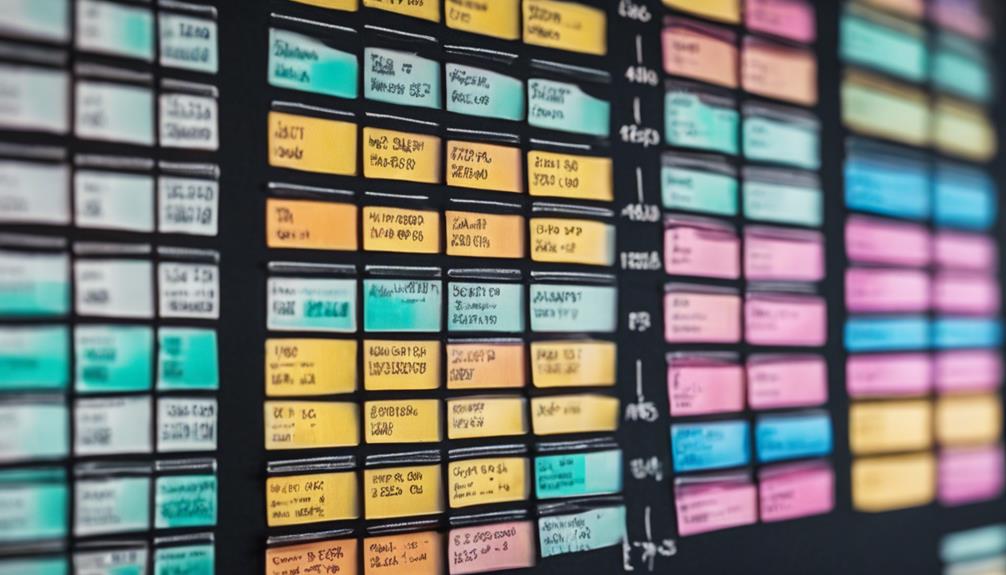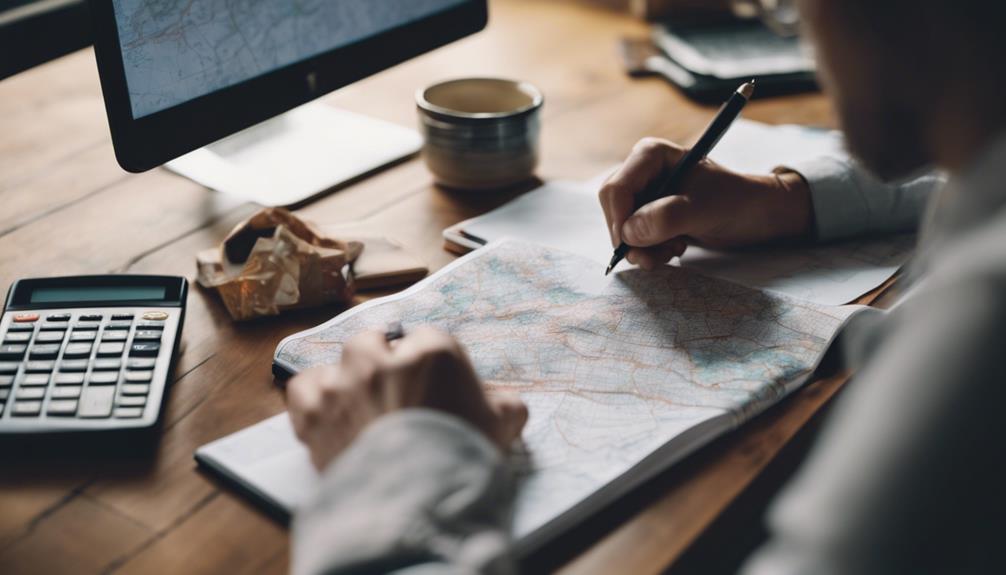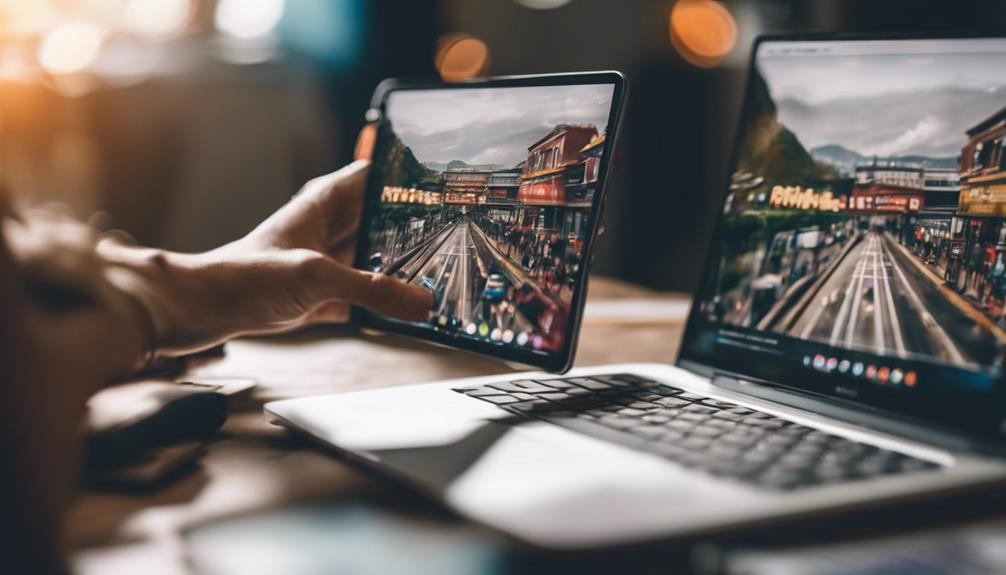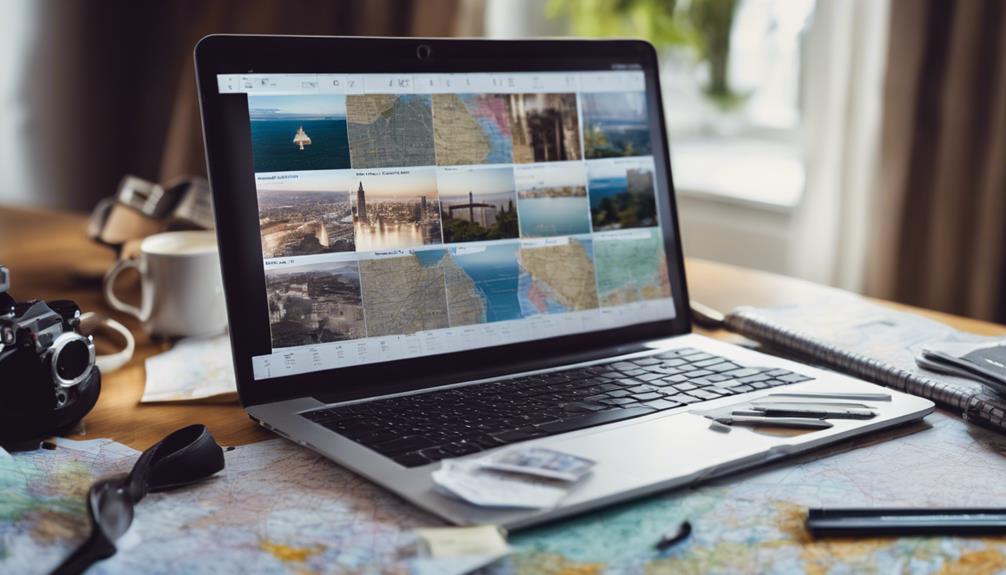Crafting my dream trip involves careful planning and budgeting to bring my travel vision to life smoothly. I start by defining my travel goals, selecting destinations aligned with my interests, and estimating overall trip costs. It's crucial to research expenses thoroughly, create a detailed budget, and continuously monitor and adjust my finances. Seeking deals and alternatives, being flexible with travel dates, and exploring unique lodging options are helpful strategies. Setting a budget for souvenirs and gifts is essential to avoid overspending. These steps guarantee a well-organized and budget-friendly dream trip experience.
Key Takeaways
- Define desired experience and travel duration.
- Select destinations aligned with interests and budget.
- Estimate trip costs for accommodations, food, activities.
- Monitor expenses and adjust finances accordingly.
- Seek deals by traveling off-peak and exploring discounts.
Setting Travel Goals

When planning your dream trip, it's important to start by setting clear travel goals. By defining the type of experience you desire, whether it's a relaxing beach vacation, an adventurous backpacking trip, or an immersive cultural exploration, you lay the foundation for a memorable journey. Determining the duration of your travels, whether it's a short weekend getaway or a long-term expedition, helps shape your itinerary and budget accordingly.
Setting travel goals involves selecting destinations that align with your interests, considering factors like attractions, culture, and activities that excite you. Identifying must-have experiences, such as sampling local cuisine, exploring historical sites, or engaging in outdoor adventures, adds depth to your travel plans and ensures a fulfilling trip. These goals also play an important role in estimating the overall trip cost, encompassing expenses like transportation, accommodation, food, activities, and any additional costs that may arise.
Selecting Destinations
To choose the perfect destinations for your dream trip, consider various factors like weather, attractions, safety, and budget constraints. Start by researching the weather and peak seasons of potential destinations to make sure your visit aligns with your preferences.
Look for unique experiences and attractions that resonate with your travel goals, seeking out destinations that offer something special and innovative. Additionally, check for any travel advisories or safety concerns in the selected locations to prioritize your well-being.
Evaluate budget constraints by researching the cost of accommodations, activities, and dining in each destination, making certain they fit within your financial plan. Ultimately, choose destinations that not only match your budget but also offer the experiences you desire.
Estimating Trip Costs

When planning your dream trip, it's important to accurately estimate your expenses to guarantee a smooth journey. Researching accommodation, transportation, food, activities, and other miscellaneous costs will help create a detailed budget.
Budgeting Essentials
As I plan my dream trip, estimating the costs is essential for effective budgeting. To create a detailed budget, I follow a step-by-step guide that includes estimating expenses for accommodations like hotels, hostels, or vacation rentals.
Transportation costs, such as flights, trains, rental cars, and public transport, are important factors to take into account. Additionally, budgeting for food and dining expenses based on personal preferences ensures financial preparedness.
Planning for activities, attractions, and tours allows for the inclusion of desired experiences in the budget. Miscellaneous costs like travel insurance, souvenirs, and unexpected expenses are also considered in my overall budget planning.
Cost-Saving Strategies
In analyzing trip costs, exploring cost-saving strategies is crucial for maximizing budget efficiency. When estimating expenses, researching accommodation options like hotels, hostels, and vacation rentals can help find the best deals. Consider various transportation choices such as flights, trains, rental cars, and public transport to optimize cost-effectiveness.
Planning food expenses based on dining preferences and budget constraints is essential. Additionally, budgeting for activities by researching entrance fees and tickets can prevent overspending. Don't forget to include travel insurance and miscellaneous costs for a thorough overview of expenses.
Researching Expenses
Researching expenses for your dream trip involves carefully analyzing the costs associated with accommodation, transportation, dining, activities, and miscellaneous items. To start this step in the planning process, I recommend creating a spreadsheet or using a budgeting app to track and compare potential expenses.
For accommodation, consider the range from budget-friendly hostels at around $50 per night to luxurious hotels exceeding $200 per night. Transportation costs can vary greatly, with domestic flights averaging $300-$500 round trip and international flights ranging from $800-$1500.
When budgeting for dining, anticipate spending between $10-$50 per meal depending on your preferences. Activities and attractions may range from free options to guided tours or entrance fees costing $50-$100.
Don't forget to include miscellaneous expenses like travel insurance, souvenirs, and tips, which can add up to 10-20% of your total trip cost. By meticulously researching these expenses, you can create a realistic budget and ensure a financially sound dream trip.
Creating a Detailed Budget

When crafting a detailed budget for your dream trip, it's essential to carefully allocate funds for transportation, dining, activities, and emergencies. Begin by estimating costs for flights, trains, and rental cars to guarantee your travel plans are accounted for.
Setting aside a daily budget for food and dining expenses can help you manage your spending while enjoying local cuisine. Budgeting for activities, tours, and attractions is vital to ensure you can participate in all the experiences you desire without overspending.
Additionally, including a contingency fund for emergencies will provide peace of mind and cover any unexpected costs that may arise during your journey. By prioritizing these budgeting aspects, you can plan a trip that's both financially feasible and fulfilling.
Remember to stay vigilant in monitoring your expenses to stay within budget and make adjustments as needed to avoid any financial pitfalls.
Monitoring and Adjusting Finances
To effectively manage my finances while on my dream trip, I must diligently track my expenses using budgeting apps or spreadsheets. By monitoring my spending regularly, I can guarantee that I stay within the budget set for the trip. This proactive approach allows me to identify areas where costs can be trimmed to prevent exceeding my financial limits.
Opting for budget-friendly dining options and making use of public transportation can help save on expenses related to food and transportation. Additionally, seeking out free or low-cost activities enables me to enjoy my travel experience without overspending.
Continuously adjusting my finances based on this monitoring process ensures that I can make the most of my dream trip without breaking the bank. Embracing these innovative methods of tracking and adjusting my expenses will lead to a more financially sustainable and rewarding travel experience.
Seeking Deals and Alternatives

When planning my dream trip, I always keep an eye out for discounts and deals to stretch my budget further. Traveling during off-peak times not only saves money but also allows for a more relaxed experience with fewer crowds.
Exploring alternative lodging options like homestays or hostels is a great way to find budget-friendly accommodations.
Bargain Hunting Tips
Scouring through various travel websites like Skyscanner and Booking.com can unearth enticing deals on flights and accommodations, paving the way for a frugal yet fulfilling journey. When hunting for bargains, I often look for discount codes and coupons to save on tours, activities, and attractions.
Exploring off-peak season discounts and promotions can also make popular destinations more affordable. To stretch my budget further, I consider alternative lodging options such as Airbnb, hostels, or guesthouses.
Additionally, immersing myself in local markets and trying street food not only offers affordable dining options but also authentic culinary experiences. By being savvy and open to alternatives, I can enjoy a fantastic trip without breaking the bank.
Budget-Friendly Options
Seeking budget-friendly options while planning your dream trip involves exploring off-peak season deals, alternative lodging choices, and discounted activities to maximize your travel budget.
By being flexible with your travel dates, you can take advantage of lower prices on accommodations and transportation. Consider unique lodging options such as homestays or hostels, which not only provide cost-effective stays but also offer a more immersive travel experience.
Look for discounts on activities and attractions, allowing you to enjoy your trip without breaking the bank. Setting a reasonable budget for souvenirs and gifts will help you avoid overspending.
After your trip, assess your expenses to identify areas where you can further improve your budgeting for future travels.
Frequently Asked Questions
How Do I Plan a Dream Trip?
To plan a dream trip, I start by envisioning my ideal destination and experiences. Researching costs and creating a detailed budget helps me stay on track financially. By setting clear goals and budgeting wisely, I craft a memorable journey.
How Do You Plan a Trip Step by Step?
To plan a trip, research destinations, choose accommodation wisely, book transportation, craft a detailed itinerary, and stay flexible to adapt. It's about seizing opportunities, immersing in cultures, and creating unforgettable memories.
How Do You Plan and Budget a Trip?
Planning and budgeting a trip involves researching costs, creating a detailed budget, monitoring expenses, and practicing resourcefulness. By staying flexible, seeking deals, and reviewing spending afterward, I secure a well-planned and cost-effective travel experience.
How Do I Make My Own Travel Itinerary?
To make my own travel itinerary, I research attractions, plan activities with allocated time, factor in relaxation and spontaneity, pre-plan meals, and note cultural events. This guarantees a well-rounded trip with experiences tailored to my interests and preferences.
Conclusion
I hope this guide has helped you take the first steps towards planning your dream trip.
Did you know that according to a recent survey, 72% of people say that travel is their biggest passion?
By setting travel goals, creating a detailed budget, and seeking deals, you can make your dream trip a reality.
Remember, with careful planning and budgeting, the world is yours to explore!

